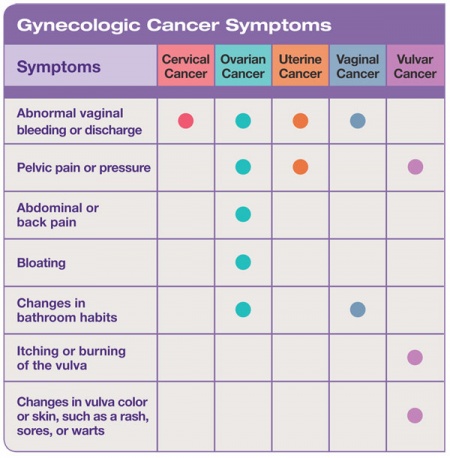Ovarian Cancer
Original Editors - Trisha Counce & Brandy Hirsch from Bellarmine University's Pathophysiology of Complex Patient Problems project.
Top Contributors - Brandy Hirsch, Trisha Counce, Lucinda hampton, Aminat Abolade, Vidya Acharya, Elaine Lonnemann, WikiSysop, Kim Jackson, 127.0.0.1, Wendy Walker and Rishika Babburu
Definition/Description[edit | edit source]
The term "ovarian cancer" encompasses several types of cancer that all arise from cells of the ovaries in the female reproductive system.[1] Ovarian cancer commonly manifests as three different types including epithelial (cells on the surface of the ovary), fallopian tube, and primary periotoneal (lining inside the abdomen). Epithelial ovarian cancer accounts for about 70% of all ovarian cancers, making it the most common type.[1] The four most common cell types of epithelial ovarian cancer are serous, mucinous, clear cell, and endometrioid. Of these cell types, serous is the most common variety.[1] Ovarian cancer is believed to occur due to changes in cell DNA. Unfortunately, ovarian cancer often goes undiagnosed until advanced stages of the disease when it is hardest to identify the initial source.
Prevalence and Incidence
[edit | edit source]
Characteristics/Clinical Presentation[edit | edit source]
Epithelial ovarian cancer presents with a wide variety of vague and nonspecific symptoms.[3] Ovarian cancer may cause one or more of these signs and symptoms--
- Bloating, which is when the area below your stomach swells or feels full [3][4][5]
- Vaginal bleeding or discharge (not normal for individual) [4][3]
- Pain in the pelvic or abdominal area, abdominal distension or discomfort, abdominal mass [4][3]
- Back pain [4][5]
- Feeling full quickly while eating [4][3][5]
- Painful urinination or frequent urges, constipation, or diarrhea [4][5]
- Indigestion and acid reflux [3]
- Shortness of breath (SOB) [3]
- Weight Loss
- Persistent lack of energy [5]
Physical findings are uncommon in patients with early disease, but the more advanced the disease one may present with ovarian or pelvic mass, ascites, pleural effusion, or abdominal mass or bowel obstruction. [3] Pay attention to your body, and know what is normal for you. If you have vaginal bleedingand/or an abnormal menstral cycle that is not normal for you, see a physician right away. The key is early intervention so the earlier ovarian cancer is found and treated, the more likely treatment will be effective. [4]
Below is a symptom chart differentiating gynecological cancers
Associated Co-morbidities[edit | edit source]
add text here
Medications[edit | edit source]
-The drug bevacizumab has also been used experimentally in the initial treatment of ovarian cancer.
-Some centers are starting to experiment with heated intraperitoneal chemotherapy (HIPEC). However, at this time, HIPEC is very experimental. There are significant risks and complications from surgery with HIPEC,
-paclitaxel
Diagnostic Tests/Lab Tests/Lab Values[edit | edit source]
add text here
Etiology/Causes[edit | edit source]
add text here
Systemic Involvement[edit | edit source]
add text here
Medical Management (current best evidence)[edit | edit source]
add text here
Physical Therapy Management (current best evidence)[edit | edit source]
add text here
Alternative/Holistic Management (current best evidence)[edit | edit source]
add text here
Differential Diagnosis[edit | edit source]
add text here
Case Reports/ Case Studies[edit | edit source]
add links to case studies here (case studies should be added on new pages using the case study template)
Resources
[edit | edit source]
add appropriate resources here
Recent Related Research (from Pubmed)[edit | edit source]
see tutorial on Adding PubMed Feed
Extension:RSS -- Error: Not a valid URL: addfeedhere|charset=UTF-8|short|max=10
References[edit | edit source]
see adding references tutorial.
- ↑ 1.0 1.1 1.2 Green A. Ovarian Cancer (Cancer of the Ovaries). MedicineNet.com. http://www.medicinenet.com/ovarian_cancer/article.htm. Updated September 24, 2013. Accessed March 12, 2014.
- ↑ Medical Information. National Ovarian Cancer Coalition. http://ovarian.org/what_is_ovarian_cancer.php. Accessed March 12, 2014.
- ↑ 3.0 3.1 3.2 3.3 3.4 3.5 3.6 3.7 Green A. Ovarian Cancer. Medscape. http://emedicine.medscape.com/article/255771-overview#a0101. Published 1994-2014. Updated March 10, 2014. Accessed March 12, 2014.
- ↑ 4.0 4.1 4.2 4.3 4.4 4.5 4.6 Ovarian Cancer. Center for Disease Control and Prevention. http://www.cdc.gov/cancer/ovarian/index.htm. Updated June 17, 2013. Accessed March 12, 2014.</ref>
- ↑ 5.0 5.1 5.2 5.3 5.4 Cite error: Invalid
<ref>tag; no text was provided for refs namedMayo







